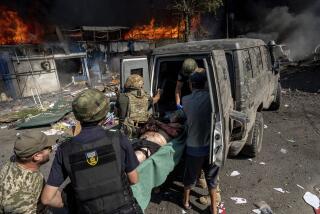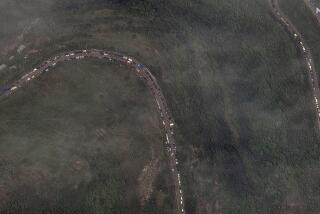Spreading Chaos in Central Asia
- Share via
WASHINGTON — One failed state is a tragedy, but a region rife with intolerance is an invitation to unending instability.
In striking testament to the disorders of post-Cold War diplomacy, the states of Central Asia now confront stark choices between democratic pluralism and authoritarian centralism. Terrorist incidents this past year have placed basic issues in sharp relief, underlining the fragile relationships among the states of the region and their separate, precarious paths toward sovereignty and stability. The future of universal political participation, the place of Islam in the state and the role of small countries in this vast region--all challenge the tolerance of states and the ingenuity of civil society as these nations step delicately around deeply divisive issues on the road toward democracy.
One month ago, where the borders of Kyrgyzstan, Tajikistan and Uzbekistan meet, armed guerrillas raided several villages in Kyrgyzstan and took hostages. Kidnapping and hostage-taking turned into cross-border bombings and population displacements, transforming a peaceful corner of Central Asia into the newest casualty of post-Soviet politics. The place this occurred, in the shadow of the Pamir mountains, where state boundaries bisect old tribal and ethnic communities, symbolizes the permeable perimeters of contemporary Central Asia.
Composed primarily of disaffected Uzbeks belonging to Islamist parties outlawed by Uzbekistan’s President Islam Karimov, the guerrillas reportedly included Tajiks and a small contingent of Afghans and Arabs. In short order, the Kyrgyz military stepped in to surround the guerrillas, the police undertook surveillance and arrests of ethnic Uzbek citizens of Kyrgyzstan, and the government called on Russia for support.
The short-term aim of the guerrilla action was to secure safe passage to Uzbekistan, presumably to foment a popular uprising, and the release of Islamist leaders held by the Uzbekistan government. In the past year, which witnessed an attempt on Karimov’s life that he attributed to Islamist militants, Tashkent has imposed order by limiting civil-rights protections.
The virus of creeping authoritarianism has spread throughout the region: Most governments have modified democratic rhetoric to favor actions to dampen popular discord and reinforce central power. If the death knell has not yet rung for dissent, opposition politics have taken new forms. One is the rising reach of Islamist groups whose very existence seems an affront to the region’s stridently secular leaders.
In a cavalcade of mutual blaming, the Uzbek government accused Tajikistan of supporting the guerrillas; the Tajiks cast aspersions on Uzbekistan for destabilizing the region; and Kyrgyz President Askar A. Akayev held Osama bin Laden and neighboring Afghanistan’s Taliban movement accountable for sacrificing secular democracy on the altar of a prospective Islamist Central Asia. The small Kyrgyz and Tajik states co-exist uneasily with their far-larger Uzbek neighbor, but their attempts to use Russia as a counterweight have complicated regional relations. Kyrgyz authorities fear that Uzbekistan may move into their southern region, ostensibly to protect ethnic Uzbeks, but really to control a border area already penetrated by drug traffickers.
The specter of the failed Afghan state, where many Central Asians fought in the Soviet army, looms large. Many of today’s guerrillas fought in Afghanistan and Tajikistan after leaving repressive Uzbekistan in the 1990s. All the states in the region--ranging from Taliban-supporting Pakistan to Taliban-opposing Iran and Central Asia--fear uncontrollable transnational groups and the lethal mix of drugs and armaments that often fuel antistate activities.
Ultimately, it is the state that is at risk in Central Asia, as it is in the Caucasus, the Balkans and many parts of Africa, where plural populations encounter the state as either an unfulfilled promise or an obstruction to political and economic progress. The reluctantly independent states of Central Asia, which lived in relative prosperity under subsidized Soviet rule, have embraced sovereignty in vastly different ways. Uzbekistan, Turkmenistan and Kazakhstan, large and resource rich, have traded on their future profits with a mix of nationalism and authoritarianism that alternately lures and provokes investors and trading partners. Tajikistan stubbornly survives its own civil war and, with regular exchanges of refugees and militants, Afghanistan’s, too. Pluralist Kyrgyzstan, unwitting host to discord and rebel actions, has embraced every Western tutorial on economic liberalization with the sad knowledge that its investment potential is inadequate for its needs and ambitions.
The result is the lure of political and economic advantages--available for some, but still eluding the grasp of many. Opportunities exist, absent the distributive equity to which civil society was accustomed, and the promise of political participation has faded as governments seek to control resources and power. Optimists look for silver linings in the long term, hoping foreign trade and investment may bring wealth to the many and political voice to all. Pessimists, mired in short-term debt and even shorter patience, fear the longer term may come too late: Governments and states will disappear into the chasm between idealism and realism.
Under these circumstances, caricature has replaced open debate. The Uzbekistan government, condemning opposition as Muslim extremism, offers little room for dissent; Islamist groups, excluded from political discourse, target the state as the ultimate enemy. Both are right, and wrong. Central Asia’s states are creatures of an international political economy in which they are tangential. Without political pluralism, their continuing peripheral status will exacerbate domestic tensions, fostering a familiar spiral of discontent. But insurgency, with or without the veil of religion, threatens the state and citizens who still want it to endure, forcing countries like Kyrgyzstan, relatively open and open-minded, to negotiate around guerrillas rather than risk validating their means and ends.
Islam is not the problem in Central Asia, but economic, social and political dislocations may make it seem like a solution. The problem is not religion in politics, so feared by the former communists who now rule every state in the region, but a dangerous brew of terrorism and ideological intransigence that so easily infects politics in the name of populism. The shadow of Afghanistan is a close and potent reminder of what it means for political society to implode.
Central Asia’s leaders have the unenviable task of crafting a balance among forces over which they do not have equal control. Just what form their states will finally take is still an open question. But relinquishing democracy to ensure stability will be a sure sign that progress will not be achieved.
More to Read
Sign up for Essential California
The most important California stories and recommendations in your inbox every morning.
You may occasionally receive promotional content from the Los Angeles Times.













